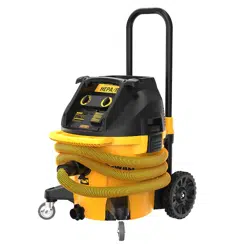Loading ...
Loading ...
Loading ...

5
ENGLISH
ON MOTOR HOUSING (on back of
vacuum head):
WARNING:
• TO REDUCE THE RISK OF INJURY, USER MUST READ
INSTRUCTION MANUAL. DO NOT RUN UNATTENDED.
DO NOT PICK UP FLAMMABLE, COMBUSTIBLE OR HOT
MATERIALS. DO NOT USE AROUND EXPLOSIVE DUST,
LIQUIDS OR VAPORS. ELECTRICAL DEVICES PRODUCE
ARCS OR SPARKS WHICH CAN CAUSE FIRE OR EXPLOSION.
DO NOT USE AT FILLING STATIONS OR ANYWHERE
GASOLINE IS STORED OR DISPENSED. DO NOT VACUUM
TOXIC OR CARCINOGENIC MATERIALS OR OTHER HEALTH
ENDANGERING MATERIAL SUCH AS ASBESTOS OR
The label on your tool may include the following symbols. The
symbols and their definitions are asfollows:
V ......................... volts
Hz .......................hertz
min ..................... minutes
or DC ......direct current
...................... Class I Construction
(grounded)
…/min ..............per minute
BPM .................... beats per minute
IPM ..................... impacts per minute
OPM .................... oscillations per
minute
RPM .................... revolutions per
minute
sfpm ................... surface feet per
minute
SPM .................... strokes per minute
A ......................... amperes
W ........................watts
Wh ......................watt hours
Ah ....................... amp hours
or AC ...........alternating current
or AC/DC .... alternating or direct
current
...................... Class II Construction
(double insulated)
n
o
.......................no load speed
n .........................rated speed
PSI....................... pounds per square
inch
......................earthing terminal
.....................safety alert symbol
..................... visible radiation–
do not stare into
the light
..................... wear respiratory
protection
..................... wear eye protection
..................... wear hearing
protection
..................... r
ead all documentation
.....................
do not expose to rain
• Do not pick up anything that is burning or smoking, such
as cigarettes, matches, or hotashes.
• Do not use to vacuum combustible explosive
materials, such as coal, grain, or other finely divided
combustiblematerial.
• Do not use to vacuum hazardous, toxic or carcinogenic
materials, such as asbestos or pesticide, unless the
vacuuming of the material is specifically identified in this
instruction manual as an approveduse.
• Never pick up explosive liquids (e.g. gasoline, diesel fuel,
heating oil, paint thinner, etc.), acids orsolvents.
• Do not use vacuum without filters in place, except as
described under Wet PickupApplications.
• Some wood contains preservatives which can be toxic. Take
extra care to prevent inhalation and skin contact when
working with these materials. Request and follow any
safety information available from your materialsupplier.
• Do not use vacuum as a stepladder.
• Do not place heavy objects onvacuum.
Additional Safety Information for
DustExtractors
• Connect to a properly grounded outlet only (See
Grounding Instructions).
• This vacuum meets the EPA lead‑related Renovations,
Repair and Painting (RRP) Rule for HEPA vacuum only when
used with the DWV9320 or DWV9330 HEPA Filter. (included
with DWV015).
Contact the United States Environmental Protection Agency
(EPA) for more information on their Renovations, Repair
and Painting (RRP)Rule.
• This vacuum is approved for use in OSHA Silica 1926.1153
dust collection applications when properly utilized per the
OSHA 1926.1153ruling.
as those dust masks that are specially designed to
grease tube cavity out microscopicparticles.
• Wear protective clothing and wash exposed areas
with soap and water. Allowing dust to get into your
mouth, eyes, or lie on the skin may promote absorption of
harmfulchemicals. Direct particles away from face andbody.
• Use the appropriate dust extractor vacuum to remove
the vast majority of static and airborne dust. Failure
to remove static and airborne dust could contaminate the
working environment or pose an increased health risk to
the operator and those in closeproximity.
• Use clamps or other practical ways to secure and
support the workpiece to a stable platform. Holding
the workpiece by hand or against your body is unstable
and may lead to loss of control andinjury.
• Air vents often cover moving parts and should be
avoided. Loose clothes, jewelry or long hair can be caught
in movingparts.
• An extension cord must have adequate wire size
(AWG or American Wire Gauge) for safety. The smaller
the gauge number of the wire, the greater the capacity
of the cable, that is, 16gauge has more capacity than
18gauge. An undersized cord will cause a drop in line
voltage resulting in loss of power and overheating. When
using more than one extension to make up the total length,
be sure each individual extension contains at least the
minimum wire size. The following table shows the correct
size to use depending on cord length and nameplate
ampere rating. If in doubt, use the next heavier gauge. The
lower the gauge number, the heavier thecord.
Minimum Gauge for Cord Sets
Volts
Total Length of Cord in Feet
(meters)
120 V 25 (7.6) 50 (15.2) 100 (30.5) 150 (45.7)
240 V 50 (15.2) 100 (30.5) 200 (61.0) 300 (91.4)
Ampere Rating
American Wire Gauge
More
Than
Not
More
Than
0 6 18 16 16 14
6 10 18 16 14 12
10 12 16 16 14 12
12 16 14 12 Not Recommended
Loading ...
Loading ...
Loading ...
